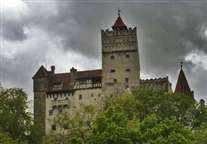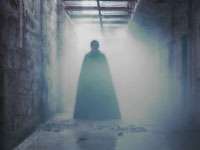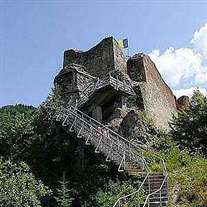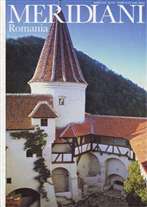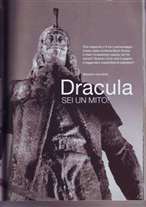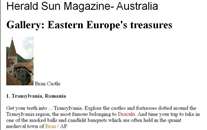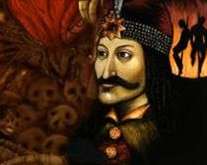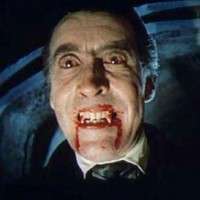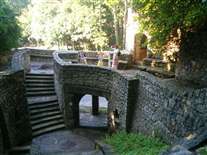Forbes_Traveler.jpg
Forbes Traveler
Fall Travel
World's Spookiest Spots
Anna Vander Broek, 10.19.07, 12:00 PM ET
In Pictures: World's Spookiest Spots
If you're looking for ghosts and ghouls this month, chances are you'll get a better fright in Romania than you will trick-or-treating down Elm Street.
Head to a region of the country known as Transylvania and you'll find Bran Castle, also called "Dracula's Castle." It's said that Dracula author Bram Stoker based the novel's seductive, blood-sucking vampire on the very real 15th-century Prince Vlad the Impaler, who lived in the castle from 1456 to 1462.
The scary space is now a museum. Step inside, and its gothic architecture, winding stairways and narrow, underground passages alone might send a chill up your spine. If that doesn't do the trick, attend any number of daily "witch trials" reenacted on the castle's grounds. Here, actors recreate the vicious methods of torture, including hangings, burnings at the stake and beheadings, that Vlad the Impaler used on his enemies.
Hunt_for_Dracula.jpg
Hunt for Dracula -Travel Channel
Haunted Travels
Mysterious Journeys
Hunt for Dracula
by Kwin Mosby
The vampire is one of the oldest figures in mythology. Ancient Babylon, Egypt, South America and nearly every civilization has its own ancient texts describing creatures of the dead that prey upon the living.
Irish author Bram Stoker may have chose Romania as the setting for his horror novel, "Dracula," for several reasons, but he was intrigued by the country's old-world feel. So he switched the original setting from Austria to Transylvania, an infamous region in Romania.
Nearly 90-percent of Romania belongs to the Easter Orthodox Church. In some areas in Romania, people are really afraid of death and will do everything to avoid death.
One spooky ritual known as the killing of the living dead is a grisly tradition still practiced today in the countryside. The villagers have been known to dig up the dead buried body of the person that is haunting them. They cut out the heart and burned the body. The ashes would be turned into a potion. The people haunted by the dead person would drink the potion to rid them of the haunting spirit.
According to Romanian tradition, a corpse will not decay until the body's spirit has passed into heaven or hell. For this reason, Romanians dig up the bodies after an interval of 7 years. If the bones are white and clean, then the soul has entered into eternal rest. If the decomposition is not complete; it's believed that the soul has been trapped on earth, becoming a ghostly, vampire-like creature known as a Strigoi. A Strigoi does not suck blood like Dracula. It is merely a predator, stealing milk from cows; destroying harvests; or causing impotence.
Killing a Strigoi seems eerily similar to slaying Dracula. Most of the rituals to 'set the soul free' are: decapitation, burning, and putting a wooden stake through the heart. In all these practices, garlic, the cross, holy water, and or basil is used.
Bram Stoker may have also gain some inspiration for his popular novel from Negru Voda, which translated means 'the dark prince.' It refers to an ancient ruler in southern Romania. He was a young nobleman who longed to make his mark on the world. He was willing to make sacrifices to get it. The only clues of his existence are hidden in the shadows of Romania's Southern Carpathian Mountains in an ancient city called Curtea de Arges.
Across Romania, Dracula isn't just a name in fiction. It refers to a real-life notorious 15th century noble known as Vlad Dracula. Known as Vlad Tepes or Vlad the Impaler, Vlad Dracula was the son of Vlad Dracul and legendary for impaling thousands. Most Romanians claim that the connection between Stoker's Dracula and Vlad Dracula ends with the name.
Tourists can head to southern Romania to a medieval region known as Wallachia to separate the fact from the fictions. It was here, even before Vlad was born, his father was recruited by a secret order known as the order of the Dracul. The Order of Dracul was out for blood. They were determined to protect Europe's Christian nobility from invading Muslim Turks.
No one knows where Vlad was born, but some believe it was in Sighisoara in 1431. Still one of the best preserved medieval fortresses in Europe, Sighisoara's narrow streets and dark alleys definitely seem like the perfect breeding ground for a notorious blood fiend.
Vlad's legendary house where he was born is Casa Dracul. Today it is a carefully restored restaurant filled with narrow stairways and Dracula artifacts. Only a couple doors down tourists can check out Vlad's favorite instruments of torture inside a museum located in the giant clock tower in Sighisoara.
Bram Stoker came up with the perfect setting for his famous novel. There are more than 25 species of bats in Romania. Wallachia was Vlad's kingdom situated between Transylvania and the Ottoman Empire. It was the bloody battleground between the Orthodox Romanians and the Islamic Turks. Now, Vlad Dracula's capital fortress at Tirgoviste lies in ruin. The most impressive feature still standing is the Chindia Lookout Tower. It was likely here that he plotted some of his most bloodthirsty acts of revenge.
Tourists can head to Poienari, which is also known as the Citadel of the Black Prince. It's said that the stink of bodies of nobles - who were not impaled, blinded or skinned alive - could be smelled from miles away.
One piece of evidence suggests that Vlad may have been a true vampire like Dracula - actually dining on the flesh of his victims. Engraved around the time of Vlad's death, a German woodcut shows Vlad dining on meat surrounded by various dismembered bodies.
After fleeing the castle in fear of the Turks approach, most believe Vlad was beheaded by the Turks - his head saved by the Turkish Sultan as a trophy. Others believe he may be buried somewhere in Romania.
Tourists can also take a tour of some spooky spots described in Stoker's novel. They can head to Bistrita, Romania. Since 'Dracula' was published, a modern hotel called the Golden Crown Hotel has been built. Bram Stoker imagined it. Tourists can head up to the Borgo Pass - a place that's almost as chilling in real-life as it is in the novel. Visitors can even take a horse-drawn carriage ride. The horses wear red tassels through the Pass to ward off evil spirits there.
Bram Stoker placed the castle of Count Dracula in Borgo Pass, but no castle existed here. The small Transylvania village known as Piatra Fintinele is another destination for Dracula fans. Inspired by the novel itself, Dracula Castel Hotel tries to copy Stoker's description from top to bottom. Tourists can venture down the hotel's dark stairwell to a real crypt with a suspicious coffin.
At the heart of Dracula is a unique look at Romania's history. By combining nobility, legends, and landscape, Bram Stoker was able to fashion a new face for terror and create a character who will outlive us all.
Pictures: Travel Channel, L.L.C
Poienari_Castle_R.jpg
Poienari Castle
Top 10 Spooky Travel Destinations
Poienari Castle
Do not be fooled by those who tell you to visit Bran Castle in Romania to see the home of the evil Vlad the Impaler (inspiration for Dracula). Bran castle is a tourist attraction and there is no known evidence that Vlad Tepes ever stayed there. However, not so far away is the ruin of Poenari Castle – Vlad’s real home in Wallachia. It was erected around the beginning of the 13th century by the first Romanian rulers in the South region of Romania. Around the 14th century, Poenari was the main citadel of the Basarab rulers. In the next few decades, the name and the residents changed a few times but eventually the castle was abandoned and left in ruins. However, in the 15th century, realizing the potential for a castle perched high on a steep precipice of rock, Vlad III the Impaler repaired and consolidated the structure, making it one of his main fortresses. After Vlad’s death the castle fell to ruin but it is still standing in part and is available for tourists. To reach the castle, visitors need to climb 1,500 steps. The castle is considered to be one of the most haunted places in the world.
From Wikipedia
Coordinates: 45°21′13.49″N 24°38′6.80″E / 45.3537472°N 24.6352222°E / 45.3537472; 24.6352222
Poenari Castle (IPA: /po.ǐe.'narʲ/) also known as Poenari Citadel (Cetatea Poenari in Romanian), is a ruined castle in Romania, in Argeş County (Căpăţânenii Pământeni village of the Arefu commune) on a canyon formed on the Argeş River valley, close to the Făgăraş Mountains. It stands on a cliff, on the right side of the Transfăgărăşan road which climbs high into the mountains. Poenari Castle is said to be one of the most haunted places in the world.
It was erected around the beginning of the 13th century by the first Romanian rulers in the South region of Romania, known as Wallachia. Around the 14th century, Poenari was the main citadel of the Basarab rulers. In the next few decades, the name and the residents changed a few times but eventually the castle was abandoned and left in ruins.
However, in the 15th century, realizing the potential for a castle perched high on a steep precipice of rock, Vlad III the Impaler repaired and consolidated the structure, making it one of his main fortresses.
Although the castle was used for many years after Vlad's death in 1476, it eventually was abandoned again in the first half of the 16th century and was in ruins by the 17th century. Due to its size and location, control of the castle was difficult to take, even by natural forces. However, in 1888, a landslide brought down a portion of the castle which crashed into the river far below. Nonetheless, the castle was slightly repaired and the walls and its towers still stand today. To reach the castle, visitors need to climb 1,500 steps.
In fiction
Bram Stoker's book says that Romanians knew Dracula's castle as "Cetatea Lui Negru Vodă" or Citadel of the Black Prince, although this fictional version of the castle was situated some 200 kilometers to the north. This castle, like most other elements of the book, has little in common with its historical counterpart
Revista_Viajar.jpg
Revista Viajar and Mariano Lopez
MARIANO LOPEZ
Un ataúd lleno de patatas
GUILLERMO ABRIL - 15/11/2008
La gran travesía de Mariano López dura ya una docena de años. Un gran viaje que contiene otros más pequeños; López dirige desde 1996 la revista Viajar, que este mes cumple 30 años con un número muy especial.
Su mayor hazaña?
Recuerdo un viaje a Transilvania (Rumania) en 1997, año del centenario de la novela Drácula, de Bram Stoker. Era para escribir un reportaje siguiendo sus huellas.
Las encontraron?
Bueno, acabamos comprando un carruaje fúnebre... El viaje comenzó en Bistrita. Fuimos al restaurante Corona de Oro, allí desayuna el personaje de la novela Jonathan Harker. Lo servían todo muy rojo aposta: vino tinto, carne medio cruda. Luego fuimos a Piatra Fantanele, donde domina el hotel-castillo de Drácula (Castillo de Bran).
Se duerme bien allí arriba?
Lo más divertido es un teatro que hacen para huéspedes. Acaba con un tipo vestido de Drácula saliendo de la tumba. Una turista murió de un infarto por el susto y suspendieron la función unos años.
Y lo del carruaje?
Queríamos una foto con uno. En Piatra Fantanele nos lo consiguieron y una señora nos dejó el ataúd de su madre. Seguía viva, pero allí todo el mundo se lo hacía antes de morir, por si se quedaban sin dinero. ¡Lo tenían lleno de patatas! En Bistrita vimos otro carruaje más bonito. La idea era traerlo a España y venderlo a un club de fans de Drácula. Costó 30 euros. Y ahí seguirá, en algún garaje de Rumania.
contele_vampir.jpg
Conde Dracula
CONVOCATORIA:
6 de octubre, 18h
Cortometraje: En la biblioteca (2008/3’) de Julio Mazarico.
Largometraje: El conde Drácula (1970/98’) de Jesús Franco.
REPARTO: Christopher Lee, Herbert Lom, Klaus Kinski, Soledad Miranda, entre otros.
SINOPSIS: Transilvania, 1897. Un abogado británico llega a un siniestro castillo para entrevistar al conde Drácula, sombrío personaje interesado en comprar tierras en Inglaterra. El abogado no tardará en descubrir la verdadera naturaleza del conde.
Alexa_site.jpg
Alexa site
Dracula Forever Young
Describes the legend as linked from the Romanian story "Prince Handsome - Youth everlasting and Life without End".
